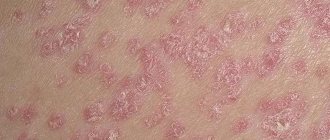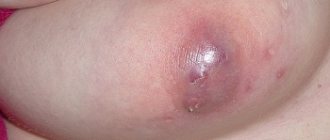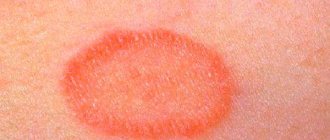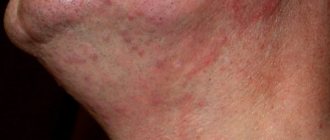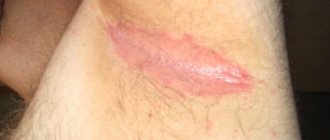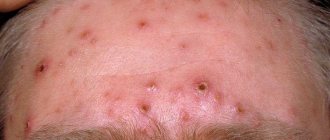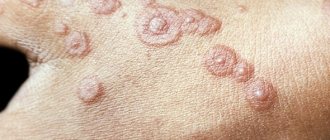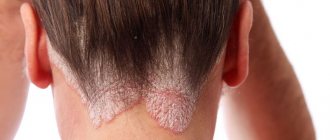Classification
Depending on the course of the disease, there are several types of scabies:
- This is the most common form of the disease and occurs with pathognomic (unambiguous) signs of scabies.
- A characteristic feature of this form of the disease is the absence of the main symptom – scabies. Instead, there are vesicles about 2-3mm in circumference. This type of disease occurs in those people who had contact with the patient, but the infection occurred not with adult ticks, but with their larvae.
- this form of the disease is typical for people who have the habit of washing frequently, or there is a need for frequent washing due to the nature of their work. This type of scabies occurs in the same way as the typical form, but the symptoms are less pronounced due to the mechanical removal of most of the mites.
- the most severe and highly contagious form of the disease. Up to a million adult mites parasitize the patient’s skin, whereas with ordinary scabies their number does not exceed 15-20 individuals. Its appearance resembles psoriasis-like dermatitis, skin hyperkeratosis is pronounced (proliferation of the upper layer of the epidermis), and there is no itching. It is often diagnosed in people with weakened body defenses (HIV-infected, tuberculosis patients), as well as in people with mental illnesses and drug addicts.
- is characterized by the formation of bluish or brown hardenings on the skin, which reach 2-20 mm in diameter and persist for several weeks even after treatment. There are no mites in the nodules.
- This form of the disease is characteristic of persons whose infection occurred not from humans, but from animals. The main symptom is severe itching and the absence of scabies. This form heals itself after the person has stopped contact with the infected animal.
- This is a form of typical scabies, which has not been treated, and is characterized by the addition of a secondary infection.
How to recognize scabies?
An unpleasant disease caused by scabies mites still exists today. Its carrier is a sick person, so you can become infected mainly from a carrier of the infection through close contact. A mature individual tick gnaws a hole in the dermis and enters the epidermis. There, making passages, she lives and reproduces. It is worth noting that the favorite places for itching to exist are the mammary glands, inguinal folds, elbows, wrists, palms, folds between the fingers, feet, and thighs. In young children, it can affect the scalp, face, and area under the nails. How to distinguish scabies from other skin diseases? There are several characteristic signs of this disease:
- Manifestation of unbearable itching of the skin, which intensifies in the evening. This is explained by the fact that tick activation occurs at night. It begins to secrete waste products, in response the person has an allergic reaction. The severity of the itching depends on the individual characteristics of the body and the number of parasites.
- Scabies on the skin look like thin winding stripes up to one and a half centimeters, ending in a small black dot - a female mite. Upon careful examination, they are visible to the naked eye. Old passages turn into small flaky cracks. You can see what scabies looks like in the photo.
- In children, the rash appears in atypical places: the head, face. The condition of the nail plates deteriorates, cracks and delamination occur.
At the slightest sign of scabies, you should urgently contact a dermatologist and submit a skin scraping for microscopic analysis. Only a doctor will prescribe the correct treatment.
Features of the life cycle of the scabies mite
The clinical manifestations of the disease are determined by the manifestation of the life cycle of scabies mites, so it is worth dwelling on it in detail.
An adult female scabies mite is about 1/3 mm in size. Their photo is shown on the right. Males are approximately 1.5 times smaller and the manifestations of the disease have no significance in the clinical picture.
Like all insects, scabies mites go through larval and adult stages in their development. After fertilization, the female penetrates into the superficial part of the skin (epidermis). Feeding on the epidermis, it moves, making passages in it, where, in addition to the products of its vital activity, it leaves eggs. In one intraepidermal passage, 3-4 fertilized eggs can be detected at different stages of development. Females make holes above the laying site to facilitate the release of the offspring to the surface of the skin. On the skin, the larvae, spreading around, penetrate into the hair follicles (hair roots), under the keratinizing scales of the skin, into various elements of the rash (especially vesicles). There they undergo transformation, bypassing intermediate stages, immediately into adult, sexually mature ticks. Mating occurs on human skin, after which the females penetrate the epidermis, and the males are cleaned off by combing, separated with microscales of the skin and die. The average lifespan of a female is 6-8 weeks, during which she lays about 60 eggs. It is estimated that the potential production of adult ticks from one female in three months can be up to 150 million individuals.
Once removed from the skin, scabies mites can remain viable in the environment at room temperature for about a week. Under less favorable conditions, females live for about three days, and larvae for about two.
A healthy person is infected through close contact with a sick person or indirectly through his things (combs, washcloths, towels, etc.).
Scabies diagnosis:
As mentioned earlier, scabies on the hands can be similar to many other skin diseases, so do not risk infecting the whole family (including infants), but go to the doctor immediately.
An experienced dermatologist will first examine the affected areas of the body, based on the patient’s medical history and complaints. However, to finally establish the diagnosis, a specialist will prescribe laboratory scraping of the skin in order to see the mite under a microscope.
A dyeing technique is also used. To do this, the doctor draws the supposed passages with a felt-tip pen and rubs alcohol into them. The ink penetrates deep into the skin and clearly shows the passages of the parasite. However, after this the patient is still sent for laboratory testing.
Most often, the disease “Scabies” occurs in crowded places: nursing homes, boarding schools, schools, universities, etc., therefore, periodic medical examinations are carried out in such institutions for timely detection of the disease, because 1 infected person can infect all visitors to the institution.
How can you get infected?
Scabies almost always occurs through prolonged direct skin-to-skin contact. The predominant route of transmission is sexual. Children often become infected when they sleep in the same bed with sick parents. In crowded groups, other direct skin-to-skin contacts are also realized (contact sports, children fussing, frequent and strong handshakes, etc.). Although a number of manuals continue to reproduce outdated information about the transmission of scabies through household items (household items, bedding, etc.), experts agree that this route of infection is extremely unlikely. The exception is cases of Norwegian scabies, when up to several million mites live on the patient’s body (in typical cases this is 10-20 mites).
The key experiment, which proved that direct contact with the patient’s skin plays a dominant role in the transmission of scabies, was performed in 1940 in Great Britain under the leadership of Mellanby. Of 272 attempts to infect volunteers by placing them in a bed from which patients with severe scabies had just risen, only 4 attempts led to illness.
READ ALSO: A child has purulent pimples on the body: causes, symptoms and treatment
Such features of the transmission of parasitosis are explained by the following data on its biology:
- the scabies mite is inactive during the day; females come to the surface only in the late evening and at night;
- The tick needs about 30 minutes to penetrate the host’s skin;
- in the external environment the tick dies quickly (at 21°C and humidity 40-80% the parasite dies in 24-36 hours), the warmer and drier the faster; The tick loses activity even earlier.
Currently, more and more manuals and medical reviews include scabies along with phthiriasis in the list of sexually transmitted diseases, although for the transmission of these parasitoses it is not so much coitus itself that is important, but rather prolonged contact between bodies in bed.
Ways of infection with scabies
Scabies mites can exist in the environment for a long time. Both adults and children can get sick, especially with weakened immunity. The following routes of transmission of a pathogenic microorganism to the dermis of an individual are known:
- from a patient during close contact - sexual contact, hugging, shaking hands, being in the same bed during sleep;
- household - for general use of door handles, railings, bed linen, mattresses, clothes, toys.
However, some experts are of the opinion that it is impossible to become infected through household means. The scabies mite can be present on animals for a short time, so it is possible that the infection can spread from them, although this route of infection with scabies is extremely rare.
Symptoms of scabies in humans
The very first symptoms of scabies in humans:
- A rash in adults and children, localized in different areas and worsening at night. This is due to the fact that it is during the night hours that females are active in terms of their life activities.
- Formation of noticeable scabies-like passages.
- Polymorphism is characterized by the formation of papules and vesicles, which are covered with a hemorrhagic crust.
- Favorite sites of infection are the abdomen, folds between the fingers, lateral areas, thighs and gluteal muscles, in women - on the chest, in men - in the groin. The rash on the hands becomes especially noticeable.
- When the disease occurs, red spots form on the body, always itching, they are “covered”, “surrounded” by lines that have an unattractive gray tone.
From the moment of infection to the appearance of the first signs of scabies, less than a day can pass, sometimes a week or more. The incubation period of the disease may vary. It is determined by the time of year and the number of parasites that get on the skin.
- The main symptom of the initial stage is itching. Its intensity is increasing. This symptom becomes especially strong in the evening and at night. This can be explained by an increase in pathogen activity towards the end of the day.
- Presence of scabies. Scabies are slightly raised straight or curved white, gray lines on the skin, less than one centimeter long. At the blind end of the passage, a vesicle is visualized, in which the female mite is located. Often, burrows appear in those areas of the skin where the stratum corneum is thickest.
- The waste products of the scabies mite cause an allergic reaction, manifested by skin rashes (papules, vesicles). Due to itching, a person scratches the elements of the rash, in place of which erosions and then bloody crusts appear. Dotted bloody crusts in the elbow area are called Gorchakov's symptom.
Typical sites of scabies rash:
- almost everyone has interdigital spaces and lateral surfaces of the fingers,
- in 50% - the area of the wrist joints,
- 50% of men have genitals,
- 25% have feet,
- 20% - torso,
- in 17% - arms and legs (excluding hands and feet),
- 10% of women have mammary glands.
And also: flexion folds of the forearms and shoulders, buttocks, hips and popliteal cavities.
A typical scabies rash consists of small red nodules that over time turn into small blisters that will soon burst, leaving behind a bloody or purulent crust.
The first signs of scabies, symptoms and photos
The first signs of scabies photo, scabies course
Typical scabies looks like skin rashes arranged in pairs, connected by a grayish tract that is visible through the skin and no more than 1 cm long.
Upon closer examination, you can see the external signs of scabies: at one end of the tract there is a skin lesion - the entrance hole, and at the other - reddish papules (deposited larvae).
Stages of scabies:
The incubation period is 7-10 days from the arrival of a scabies mite until the first signs of scabies appear. The incubation period is longer (up to 6 weeks) in very clean people who shower daily.
Massive exposure of the parasite to the skin accelerates the onset of symptoms of the disease.
Primary skin damage—initially, severe itching appears at the site of the tick’s penetration. The irresistible desire to scratch is caused not only by damage to the stratum corneum of the epidermis, but also by a specific allergic reaction to the parasite’s saliva and deposited larvae.
photo 3
Even with local spread of rashes, almost the entire body itches, especially in the evening and at night, which provokes insomnia. During the day, a person is irritable and feels embarrassed in society.
- One female makes several moves. Scratching appears on the skin, which eventually heals with the formation of serous or bloody crusts.
Repeated attack of the scabies mite - after 2-3 weeks, the hatched parasites repeat their path. The rash spreads to distant areas of the skin. Nervousness and emotional instability increase.
Stage of complications - lack of treatment for scabies and constant scratching of the skin leads to infection. As a result, small ulcers appear first, and later widespread pyoderma may develop.
Atypical forms of scabies are rare. The following options for the course of the disease are possible:
- In unscrupulous people (alcoholics, homeless people) and with immunodeficiency, itching may be practically absent even at this stage, and the only symptom of scabies will be a characteristic rash spread throughout the body.
- Scabies of clean people - scabies occurs with mild itching even in overly clean people; only isolated paired rashes can be found on their skin.
- Nodular scabies - a round reddish seal forms around the scabies tract. Most often, the nodules are few in number and are found on the genitals, in the belt area, and in the armpits.
- Norwegian scabies - occurs in people with severe immunodeficiency (tuberculosis, AIDS) and with decreased skin sensitivity (paralysis, neuropathy). Against the background of the absence of itching, foci of hyperkeratosis (thickening, roughening of the skin) form, growing along the periphery and merging into large areas. Pathological changes spread to the face, nail plates, and hair. Panaritiums are adjacent to dirty yellow crusts up to 3 cm thick.
- Pseudoscabies is caused by the bites of mites living on the skin of animals. Single or multiple (not paired!) bites provoke local redness and severe itching within a few hours. Pseudoscabies is not infected and with a small number of bites does not require treatment.
Important! A characteristic sign of scabies, which can be identified at home already when the first symptoms appear: staining the skin at the site of the rash with iodine or methylene blue clearly reveals the scabies tracts located in the stratum corneum.
Scabies of clean people
This is an erased form of the disease that occurs in people who have normal immunoreactivity, as a result of which there is no allergic reaction to the presence of mites.
Increased attention to personal hygiene, when people take a shower several times a day and change their underwear and bed linen, also contribute to the erasure of clinical manifestations of scabies. It is characterized by single rashes on the chest and around the navel, which practically do not macerate and do not cause discomfort, only itching is noted at night.
Hemorrhagic crusts may appear.
First signs
In places of infection, most often on the legs and arms, barely noticeable stripes one centimeter long appear. You can recognize them by their characteristic bumpy surface, which is white. Underneath it is a passage dug by the female. The vital activity of the tick contributes to the formation of a large amount of toxins.
They provoke the appearance of a rash - a skin reaction to external and internal irritants. Along the trail, itching occurs and intensifies at night. The combination of similar symptoms in adults and children is a sure sign of scabies. Having discovered them, you must immediately seek medical help and do not try to treat yourself.
Invasion of scabies mites can cause a number of complications. Among them are scabious skin lymphoplasia, pyoderma, microbial eczema and dermatitis. It is difficult to eliminate them, so it is important to abandon traditional therapy methods in favor of drug regimens selected by a dermatologist.
Norwegian scabies
Named this way because it was first described in Norway in patients with leprosy (leprosy) in the mid-19th century.
This is the most contagious and malignant form of scabies. Occurs in individuals who have persistent background suppression of the immune system for various reasons. For example, after undergoing chemotherapy for cancer, during hormonal therapy for some severe diseases with corticosteroids. Patients with Down syndrome and HIV-infected people are at risk of developing a severe form. Skin sensitivity disorders observed with paralysis of various etiologies, some other diseases, and congenital features of keratinization of the skin can also contribute to the transition of the classical form of scabies to the Norwegian one.
- A variety of rash elements that are confluent in nature, from spots to blisters, the presence of ulcerated cracks in the skin.
- The appearance of crusts of various shades of yellow and brown. Increasing in thickness and merging, they can form a kind of “shell” over parts of the body.
- In the crusts, when studied, a huge number of mites are revealed at different stages of their life cycle. Sometimes their number reaches 200 per cm².
- The parasite can also be detected on the nail plates, which, under the influence of fungal flora, thicken and become loose, convenient for the tick to inhabit and the development of its offspring.
- Joining the described picture with extensive pustular skin lesions, furunculosis, due to the addition of a secondary infection.
- There is a prolonged rise in temperature.
READ ALSO: Can a wen develop into a malignant tumor (cancer)
Causes and pathogenesis of the disease
There are different types of ticks, but only a few of them pose a threat to humans. Scabies mites - itching - belong to this type. These parasites are microscopic in size, so they cannot be seen with the naked eye.
The words “itching” and “scabies” very accurately define the picture of the disease: severe itching forces one to scratch the affected area. The hands are most often affected. In most cases, the localization of scabies on the hands is in the places between the fingers, where there are conditions for a comfortable habitat for mites.
Infection occurs through contact. Males and female scabies mites play different roles in the development of the disease. When contacted with skin, adult mites mate. The female, which has paws with suction cups, is attached to the skin. With her teeth she makes a kind of tunnel, making special holes as she moves through which air passes into the channel. Moving inside the passage, the female begins to lay eggs once a day.
When the eggs mature, larvae are formed, which escape through the holes made by the females. The period of formation of adult ticks from larvae is about two weeks. When they reach sexual maturity, they mate, and the development cycle of the parasites takes a new turn. Male scabies mites do not have the ability to penetrate the skin and die after mating. Females live for approximately one month.
During the day there is no particular activity of ticks. Channeling begins in the evening, so closer to night the itching begins to intensify. Fertilization occurs at night. Females are specially selected to the surface for this purpose.
Scabies is one of the diseases that are transmitted, in addition to contact, through sexual contact. The role in this is played by the contact of the skin in bed. Since infection occurs through contact, a prerequisite for its prevention is the presence of a separate bed for the patient. It is also necessary to change the patient’s bed linen every day, and air mattresses, pillows and blankets.
If there are pets in the house, patients should not pet them. In this case, ticks can transfer to the fur of animals, and then to the skin of a healthy person, who also strokes them. It is better to entrust caring for pets to other family members during this time.
Scabies mites are very sensitive to environmental influences. Both high temperature and frost are detrimental to them. When boiled or frozen, they die very quickly.
Nodular scabies
The nodular form of scabies develops as a result of the body’s most pronounced reaction to the waste products of the parasite. In response to the formation of toxic substances, the immune system responds with allergic manifestations: the appearance of a red rash in the form of nodules and intense itching.
- The nodules are located directly above the scabies passages and, when scratched, become covered with rough, dry crusts.
- Round nodules reach a diameter of 20 mm, they are few in number and are located in the groin area, on the inner thighs, in the armpits, on the buttocks or on the chest.
General symptoms
How does scabies start? When a pathogen enters the human dermis, typical signs of the disease do not appear immediately. The incubation period lasts from 3 to 14 days. Upon careful examination of the skin, the entry points of the itching are first visible, then with the beginning of egg laying, the clinical picture increases. The following factors should be taken into account:
- Allergic manifestations. The patient complains of lacrimation, runny nose, spots on the body, swelling of the skin, burning and itching.
- Digestive disorder. Nausea, paroxysmal abdominal pain appears, and vomiting is possible.
- Scabies. What does scabies look like in humans? On damaged areas of the dermis, thin lines of a gray or white tint appear, clearly distinguishable from the general color of the skin and visible to the naked eye. One hole contains eight channels, the length of which is up to three centimeters. They appear on the buttocks, between the fingers, the front of the abdomen, in the armpits and groin area, on the elbows, wrists, forearms, feet and external genitalia.
- Body temperature. It is possible that it will rise above 37 degrees.
- Sores on the surface of the head. This symptom is typical only for children. The tick makes its way into the scalp, leaving bite wounds that become crusty. They itch, especially at night, and bleed when scratched.
What does scabies look like in humans? Rashes characteristic of the disease appear on the dermis - small cavities filled with liquid. Without appropriate treatment, pustules and cracks form in their place, and subsequently ulcers. Crusts form on their surface, causing severe itching and causing severe discomfort.
Complications
Due to severe scratching, bacterial infection of the primary elements sometimes occurs, after which pyoderma appears.
In some rare cases, this condition leads to post-streptococcal glomerulonephritis or rheumatic heart disease. With pyoderma, boils, ecthyma and abscesses often occur, which are accompanied by lymphadenitis and lymphangitis.
Also, patients with scabies may develop allergic dermatitis or microbial eczema. Approximately half of patients with scabies are diagnosed with complications in the form of pyoderma and dermatitis. In addition, in more rare cases, other complications may occur: pyogenic pneumonia, panaritium, erysipelas, septicemia, regional lymphadenitis, internal abscesses.
Some patients develop nodular scabies, the signs of which are the appearance of bluish-purple or brownish round lumps of the skin. Such formations may not disappear for several weeks even in the absence of parasites. In addition, the manifestation of atypical forms of scabies is possible - Norwegian scabies, pseudosarcoptosis, scabies of “clean people”.
Symptoms, typical locations of rashes, differences from other similar diseases
To know exactly what scabies looks like, you need to understand how the mite behaves on human skin.
When a fertilized female mite gets on the skin, it penetrates it and begins to make scabies burrows, where it lays eggs. After 2-3 days, the larvae hatch from them. After 10-14 days, sexually mature individuals grow from the larvae.
Ticks are active in the evening and at night, which determines the symptoms of the disease.
The incubation period of the disease may vary. In some cases, it is only a few hours (when infected by an adult), in others the first signs may appear after 2 weeks (when infected by larvae).
There are several forms of scabies, each of which has its own characteristics.
1.
Typical – characterized by a triad of symptoms:
Itching – appears at the initial stage of the disease. It occurs as a result of the activity of the tick, and is also the result of the body’s immune response (allergic reaction) to the parasite and its metabolic products (saliva, excrement, eggs). Itching bothers the patient, usually in the evening and at night, when the mite is active. Sometimes it is very strong, and the patient does not sleep at night.
The rash is a reddish nodule located isolated or fused with each other. Over time, bubbles form from the nodules. They open, and bloody or purulent crusts appear in their place.
Locations of the rash characteristic of typical scabies:
- interdigital spaces and lateral surfaces of the fingers;
- feet;
- inner thigh, buttocks;
- underbelly;
- genitals;
- mammary glands in women;
- joint bends.
In advanced cases in adults, the rash can spread throughout the body, with the exception of the face and scalp.
A rash on the hands occurs with any form of scabies. This serves as an important diagnostic sign.
Scabies are the most characteristic sign of the disease. When the skin exfoliates, the passages are visible to the naked eye and look like whitish-gray scratches. Most often they are localized in areas with a thick layer of epidermis: on the hands and feet.
2. Scabies “Incognito” - occurs in people who wash themselves frequently. The symptoms in this case are the same as in the typical form, but much less pronounced.
3. Norwegian (crusted) scabies is the most contagious form. It is characterized by the appearance of crusts on the skin, which, thickening and merging with each other, form a kind of shell. The crusts contain a huge number of mites.
4. With scabious lymphoplasia, small amounts of itchy lumps with a diameter of 2-20 mm appear on the skin. This form of scabies is characterized by long-term (up to 6 months) persistence of symptoms after complete recovery.
5. Complicated scabies. The disease may be accompanied by:
- dermatitis;
- hives;
- furunculosis;
- abscesses and phlegmons of soft tissues.
The clinical picture of scabies in this case is determined by the symptoms of a specific complication.
6. Scabies without moves. It develops when infection occurs not by adults, but by larvae. There are isolated bumps and blisters on the skin, the person feels severe itching
7. Pseudosarcoptosis or pseudoscabies. As mentioned above, this form develops when ticks that parasitize large mammals (usually dogs) come into contact with the skin of a healthy person.
Scabies is often confused with bites of bedbugs, fleas, ticks, with manifestations of eczema, urticaria or shingles. In order to distinguish scabies from other pathologies, you need to remember its characteristic features:
- itching in the evening and at night;
- typical places of rashes;
- itching is of a group nature;
- scabies are noticeable on the skin (not always).
How to treat scabies?
There is a whole range of fast-acting drugs, medicines, and various ointments that help in the fight against scabies. The medicine eliminates the problem on the skin and the symptoms of the disease. Doctors have developed regimens that are important to use for certain forms of severity and stages of disease development.
Scabies at an early stage with a small number of foci of the disease includes treatment to prevent re-infection. Scabies in adults with a large number of lesions is treated with drugs that are carefully rubbed into the skin in the infected areas. The exception is the area of the face, neck, and scalp.
Treatment of scabies in humans is most effective when the mite is active - in the evening and at night. To relieve immunoallergic symptoms, antihistamines, antipruritics and corticosteroids are prescribed.
Symptoms in adults during the height of scabies
During the height of the infection, the number of rashes increases. They are characterized by polymorphism (diversity). In one area, you can see all the stages of development of the rash: red spots, nodules just beginning to form, and already mature papules, which contain translucent liquid inside. But to diagnose scabies, what matters is not what the rash looks like, but where it occurs. In the typical course of the infection, the allergic reaction initially appears on the hands between the fingers, in the folds of the forearms, shoulders, popliteal cavities, between the buttocks and on the thighs. The following photo clearly demonstrates how defeat occurs.
The rash and the presence of burrows are the main symptoms of the typical form of scabies in adults. The tunnel under the epidermis, which the female breaks through, has a tortuous bend and consists of several segments. Each of them is an element that the tick manages to make overnight. One ditch consists of 4-7 such breakthroughs. At the end there is a transparent bubble, a black dot is visible through it. This is the body of a tick.
An experienced doctor is able to make the correct diagnosis after examining the patient, even when scabies develops without a rash, but with increased itching. A dermatologist using a videodermatoscope can easily detect single tunnels. Next, he scrapes them using 40% lactic acid. This test allows you to accurately identify the infectious agent.
Medicines and preparations for the treatment of scabies in 1 day
The goal of treating any form of scabies at home is to completely destroy the mite and its larvae. Therefore, medications should loosen the stratum corneum of the skin, penetrating deep into the scabies tracts.
Currently, for the quick treatment of scabies, the following drugs, ointments and aerosols are used, which can get rid of the unpleasant symptoms of scabies in 1 day:
- Benzyl benzoate (ointment 20-30 rubles, emulsion 100 rubles) is contraindicated in children under 3 years of age, during pregnancy and lactation. Before applying the ointment, it is necessary to bathe the patient. The ointment is applied to the entire body except the head and face at night, rubbed in with hands, and hands are not washed until the morning. Only on the 4th day the treatment is repeated and on the 5th day the bed and underwear are changed.
- Lindan. Available in the form of ointment, cream, lotion. This drug is applied to dry skin for 6-24 hours and then washed off. Apply once or twice.
- Crotamiton. Used to treat pregnant women and newborns. The course of treatment is 5 days.
- Esdepalletrin (A-Par aerosol 600 rubles, Spregal aerosol 800-900 rubles). A synthetic drug, available in the form of an aerosol, is used once and is considered very convenient and low-toxic. Contraindicated for bronchial asthma and breastfeeding.
- Permethrin (Medifox bottle, gel 100-140 rubles, Nyx cream 320-400 rubles, head lice remedy Hygia 180 rubles) is rubbed into the skin of the entire body and washed off after 8-14 hours. Apply once.
- Ivermectin. Used once orally. Contraindicated for women during pregnancy and children under 5 years of age.
Principles of treatment of scabies in humans
Also during treatment you should adhere to the following recommendations:
- All patients from the same epidemic. lesions must be treated simultaneously.
- Rub the preparation with bare hands, because the hands are most often affected by scabies.
- Trim your nails: there may be tick eggs under them due to scratching.
- Remember about disinfection of linen and clothes: the tick is reliably killed by boiling for 5-10 minutes in a solution of soda or washing powder, you can also iron the clothes with a hot iron, but for the laziest there is a very simple way: the linen is removed and packed in a plastic bag for 5 days or hung outdoors. After 5 days, the clothes are considered disinfected, because hungry ticks do not survive for that long. Please note that you need to treat all fabrics that come into contact with the body - clothing and bedding. If you don't want to remove your bedding, give your sheets, pillowcases, and duvet covers a good run with a hot iron. If disinfection is carried out poorly, the remaining mites can infect you again.
- Treatment of complicated scabies is best done with benzyl benzoate ointment
or
Spregal
. - Norwegian scabies is treated in a hospital.
Sulfur ointment (33%) can be used to treat scabies in patients over 12 years of age. It is used to treat the body at night for 5-7 days. For children 2-7 years old, use 10-15% sulfur ointment twice with an interval of three to four days.
READ ALSO: Acne in teenagers
Antinistamines should definitely be used to treat scabies, including Claritin, Cetrin, Zodak, Zyrtec, Erius, etc., 2nd and 3rd generation drugs have a longer effect and have a slight sedative effect.
The Demyanovich method is also based on the acaricidal effect of sulfur. It consists of sequentially applying a 60% sodium hyposulfite solution and a 6% hydrochloric acid solution (for children, the concentrations are reduced to 40% and 4%, respectively). Between using the first and second solutions, take a break of 10 minutes. After the procedure, all clothes are changed. You can shower only on the fourth day after treatment.
The effect of the therapy is largely determined not by the drug itself, but by the correctness of its use, therefore, when treating scabies, it is important to follow several rules:
- Taking a shower, a complete change of bed linen and clothes are carried out before and after the course of treatment;
- Skin treatment should be carried out in the evening before bedtime;
- It is necessary to treat not only the affected areas, but also the entire surface of the body;
- It is necessary to regularly sanitize personal clothing and premises;
- Antiparasitic ointments should not be used for longer than directed by the doctor (even if the skin itching continues), since the drugs can cause an overdose. If itching continues after treatment, you should continue taking antihistamines.
Treatment of scabies with folk remedies
Before using folk remedies, as with drug treatment, preparatory work is done: the patient takes a shower, bed and underwear are changed and appropriately treated. It is not recommended to use folk remedies on your own without consulting a doctor. Here are some popular recipes to eliminate signs of scabies and treat the disease:
- Bay leaf and celandine. Mix the powdered dry raw materials in equal quantities with butter or melted lard. Apply to skin before bedtime. Repeat treatment up to 6 times.
- Birch tar. It is applied to the body and left on for three hours without washing off. Recipes using tar have been used to treat skin diseases since time immemorial.
- Laundry soap, onion, garlic. Dissolve the soap in a water bath, add juice squeezed from one onion and a head of garlic. After hardening, rub the affected skin twice a day.
- Lavender oil and any citrus fruit. Mix in equal proportions and lubricate the dermis twice a day.
The recipes are easy to prepare and require no skill to use. Traditional medicine methods should not be used without the use of medications for scabies.
Folk recipes
Remember that before using any folk recipes, you should consult with specialists who will tell you about the nuances of certain remedies and the possible consequences of their use. We list the most effective recipes:
- mix 1 tbsp. spoon of turpentine with 2 tbsp. spoons of butter. The resulting mixture is applied to the skin before bedtime;
- 1 tbsp. a spoonful of celandine is mixed with 4 tbsp. spoons of Vaseline. The product is intended for external use. The whole body is treated, not just the affected areas;
- Birch tar is applied in an even layer to itchy areas, washed off after 3-4 hours with warm water.
Diagnostic methods
Scabies can be detected by the traces that the mite leaves behind. But it’s difficult to see them on your own. At home, you can use an iodine solution. It needs to be applied to the affected area and brown stripes will become noticeable on the skin, which are the passages of the tick.
An excellent alternative to diagnosing scabies at home is a videodermatoscope. This method allows you to make an accurate diagnosis for any location of the scabies mite.
Diagnostic methods also include the use of lactic acid (40%). This substance loosens the very top layer of the epidermis without damaging the skin itself. Then a scraping of the affected area is made, which is examined by specialists under a microscope. During such a diagnosis, lactic acid is applied pointwise to an existing vesicle or possible tick tract.
Sometimes a technique is used to extract the parasite with a needle, after which it is studied in the laboratory. But this diagnostic method is less common and inferior to modern research.
Prevention
Prevention of scabies is quite simple. Upon completion of treatment:
- Thoroughly wipe all surfaces that an infected person may have touched;
- throw away old bedding and underwear;
- take a course of vitamins to restore the body's defenses.
Help prevent infection:
- washing hands thoroughly after visiting public places;
- maintaining household hygiene;
- a reasonable approach to choosing a sexual partner.
Scabies is a contagious skin disease, so if you experience an itchy rash, as shown in the photo, be sure to consult a dermatologist.
Description
The scabies mite is a parasite.
It is the causative agent of a disease such as scabies. In the medical literature, a description of this parasite was found for the first time in the 19th century. However, such a misfortune began to bother people much earlier. And the first mentions of it are more ancient. At that time, scientists could only speculate about what caused the disease and how it was transmitted. Only with the advent of the microscope did it become possible to study this disease. Studies have shown that scabies mite infection occurs through close contact with a person, his things and clothing. All family members can be sick at the same time. There is also an opinion that the disease is sexually transmitted, but this is impossible to prove. After all, with intimacy there is also tactile contact with the patient.
A lot of time has passed since the description of this disease, new hygiene products have appeared, the standard of living of mankind has become higher, but it has not become less relevant. Even the cleanest people are at risk.
Disinfection of housing and household items
The scabies mite lives outside of human skin for a very short time - about 5 days. In dry and hot conditions (at a temperature of 60 degrees) it dies within an hour, and at temperatures below 0 or boiling - almost immediately. Disinfection methods for scabies are based on this feature:
- underwear and bed linen, towels are boiled in a 1-2% soda solution for 5-10 minutes from the moment of boiling;
- clothes that cannot be boiled should be ironed with a steamer on both sides;
- outer clothing, as well as pillows, mattresses, blankets are placed in the open air for 5 days. In winter, one day is enough for this purpose.
Currently, the drug “A-PAR”, produced in the form of an aerosol, is used to disinfect the premises and personal belongings of the patient. It is used to process things that cannot be boiled or ironed: mattresses, pillows, blankets, outerwear, etc. In addition, the aerosol can be used to treat the room - walls, floors, door handles, furniture. Bedding should be sprayed twice.
The product does not leave stains, so there is no need to wash items after treatment, but they can be used after 2-3 hours.
Prevention of scabies
Although this disease is highly contagious, infection can be prevented.
Deep acariasis is prevented by the following actions:
- Bedding and clothes must be soaked in a 2% solution of washing powder for an hour. After washing and drying, items must be ironed with a hot iron.
- All surfaces in the room are treated with a 2% soda solution or a chlorine-based product.
- Outerwear, blankets and pillows are exposed to the scorching sun or frost for 2-3 days.
- Since scabies is transmitted sexually, promiscuity should be avoided.
Forecast
In the case of preserved immune status, the disease does not pose an immediate threat to life. Timely adequate treatment allows you to completely eliminate the symptoms and consequences of the disease. Working capacity is completely restored.
In rare cases, observed mainly in poorer countries, complicated scabies can lead to post-streptococcal glomerulonephritis and possibly rheumatic heart disease.
In children, scabies can be complicated by severe pyoderma and sepsis, even leading to the death of the patient. The prognosis for Norwegian scabies is questionable, treatment is ineffective, and there are frequent cases of death resulting from intoxication of the patient or damage to cardiac activity.
Galina
I think I got it from my cat. I went on vacation, it's called. There are few of your own sores, so here’s a couple of you. Right now I’m applying benzoate, there’s already a scab on my back. The son is smearing. It itches terribly. I was discharged from the hospital, but from the fact that I felt so many bumps that appeared there and how they managed to create so many there, it’s crazy. I thought that I just had an allergy, but the doctor looked and said scabies, I thought I would fail out of shame. I read you and I’m afraid, is it really so difficult to get rid of scabies? I'm shocked. It's the 21st century and I have scabies. I feel like a leper, I flew back and forth on the plane, I can’t understand where I got it from.
The first signs and symptoms of the disease
Incubation of the pathogen on average takes place from 1 to 10 days, the development of the disease is possible in two weeks. At the same time, the disease is characterized by some signs that allow one to immediately suspect the presence of a tick:
- Itching of the skin. In 90% of cases it is of high intensity, intensifies during sleep and weakens slightly at night. This phenomenon occurs due to the mite drilling into the deeper layers of the skin. Patients often begin to scratch their wounds in their sleep, resulting in the formation of ulcers and large cracks.
- Detection of tick passages on the surface of the skin. They are pronounced and extended whitish lines that are visible in the depths. When scratched or injured, they may appear as a tiny reddish rash with gradually peeling off crusts. Most often, ticks are located in the interdigital folds, in the armpits and groins, on the elbows, palms and feet.
- Changes in pigmentation and peeling of the skin. After the pathogen begins to secrete its metabolic products, the epidermal scales are gradually rejected and slowly peel off. At the same time, the skin in the affected area slowly darkens: quite often, even after recovery, quite large spots are observed.
- Swelling of soft tissues. With massive damage, the limb increases in size, becomes sharply painful and sensitive even to minor touches. However, most patients cannot wear tight clothing, since any contact with the skin causes them pain.
Photo gallery: main manifestations of the disease
Changes in skin color and peeling are typical for scabies
The rash occurs due to skin trauma
Scabies go deep under the skin
Features of scabies in children
A baby's body is more sensitive than an adult's body. This is largely due to the insufficient maturity of adaptation mechanisms to the environment. That is why any disease (including scabies) occurs with much more intense symptoms. In addition to the typical skin itching and peeling, in 80% of cases the child’s temperature rises to 38–39 degrees, after which severe intoxication begins. The baby often cries, refuses food, sleeps poorly and constantly injures the skin.
Children under one year of age often experience febrile seizures - a reaction to a stressful stimulus. They are spastic uncontrollable twitching of the whole body, which can be accompanied by cessation of breathing. This is an unfavorable prognostic sign and requires immediate hospitalization.
Scabies during pregnancy
During pregnancy, women's immunity is sharply reduced, therefore:
- The body is unstable against the onslaught of various types of infection
- Scabies can negatively affect the fetus if treatment is not taken promptly.
- Itching and scratching prevent expectant mothers from fully resting and gaining strength
- Constant discomfort, worries, and stress lead to a negative impact on the course of pregnancy.
A special feature of therapy is the correct selection of medications. The prescription of medications is carried out by a specialist, taking into account the woman’s well-being, health status, and the presence of allergic reactions.
Safe drugs for pregnant women:
- Spregal (aerosol) - containing a toxic substance that leads to the rapid death of the tick;
- Desloratadine, Levocetirizine - antihistamines, but with the permission of a doctor;
- Zinc ointment to relieve itching, restore the integrity of the skin, and accelerate the healing process.
Spregal Desloratadine Levocetirizine Zinc ointment
If a newborn is infected with scabies at birth, young mothers should not immediately panic. It's better to see a dermatologist.
It is prohibited to use products containing sulfur, tar, or benzyl benzoate, which can cause pathology in the fetus or lead to miscarriage.
Recommendations for scabies for pregnant women:
- Complete the full course of treatment, preferably before delivery, to avoid infection of the newborn during childbirth;
- Support immunity, take additional vitamins;
- Refuse to visit public places (sauna, steam bath), any contact with strangers, possibly carriers of infectious diseases;
- Maintain strict personal hygiene, disinfect personal space and belongings;
- At the first symptoms, contact a specialist.
In the fight against scabies in pregnant women, some traditional medicine recipes may be useful:
- Celandine juice (1 tbsp) mixed with petroleum jelly (3-4 tbsp) - apply to the body, leaving overnight and not rinsing off with water in the morning;
- Birch tar - treat the skin, leave for 3 hours, then rinse with warm water;
- Mix mustard oil (0.5 kg) with garlic (2 cloves) - boil the mixture for 10-15 minutes over low heat, treat areas affected by scabies mites;
- Figs (leaves) - squeeze the juice, wipe the affected areas.
Failure to treat scabies early during pregnancy can lead to negative consequences for women: insomnia, nervousness.
Skin lesions are fraught with the development of furunculosis, dermatitis, and infection of wounds. The appearance of pustules on the body begins to pose a potential danger to the unborn baby.
Absolutely all people, without exception, are susceptible to tick infection. If a pregnant woman falls ill, she should immediately consult a doctor. When examining the patient, he must take a scraping. What to do if a scabies mite is found in a person in this case? Treatment in such a delicate situation requires a special approach, since most medications are contraindicated for pregnant women. Treatment prescribed by a doctor can be not only outpatient, but also inpatient.
Very often, pregnant women are prescribed Spregal aerosol for scabies. It does not in any way affect the development of the fetus. It must be applied to the entire body, with the exception of the head. It is best to do this in the evening. As soon as twelve hours have passed since it was applied to the skin, you need to take a shower and thoroughly wash off the remaining aerosol with soap.
